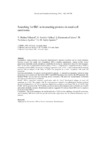Mostrar o rexistro simple do ítem
Searching for Hif1-α interacting proteins in renal cell carcinoma
| dc.contributor.author | Medina Villaamil, Vanessa | |
| dc.contributor.author | Aparicio Gallego, Guadalupe | |
| dc.contributor.author | Santamarina, Isabel | |
| dc.contributor.author | Valladares-Ayerbes, Manuel | |
| dc.contributor.author | Antón-Aparicio, Luis M. | |
| dc.date.accessioned | 2018-01-09T09:25:57Z | |
| dc.date.available | 2018-01-09T09:25:57Z | |
| dc.date.issued | 2012-08-28 | |
| dc.identifier.citation | Medina Villaamil V, Aparicio Gallego G, Santamarina Caínzos I, Valladares-Ayerbes M, Antón Aparicio LM. Searching for Hif1-α interacting proteins in renal cell carcinoma. 2012;14(9):698-708 | es_ES |
| dc.identifier.issn | 1699-048X | |
| dc.identifier.issn | 1699-3055 | |
| dc.identifier.uri | http://hdl.handle.net/2183/19960 | |
| dc.description.abstract | [Abstract] Introduction. Kidney tumours are frequently characterised by hypoxic conditions due to a local imbalance between oxygen (O2) supply and consumption. Hif1-α regulates angiogenesis, tumour growth, tumour progression, metastatic spread, and glucose metabolism by acting as a transcription factor for relevant genes. Here, we describe an immunohistochemical study of Hif1-α, a comprehensive computational study of Hif1-α interacting proteins (HIPs), an analysis correlating expression levels of Hif1-α with upstream and downstream proteins, and an analysis of the utility of Hif1-α for prognosis in a cohort of patients with renal cell carcinoma. Materials and methods. The patient cohort included 80 patients. For immunohistochemistry evaluation, tissue microarrays were constructed. The IntAct, MINT, and BOND databases were used for the HIP approach. The Kruskal–Wallis test was used for comparing protein expression with pathology measurements. Correlation was expressed as the Pearson coefficient. Results. Hif1-α expression correlates significantly with the “clear” histological subtype of renal cell carcinoma (p < 0.01). The samples with the worst prognoses related to the pathological variables analysed showed the highest levels of Hif1-α expression. Significant correlations were found with Bcl-2, CAIX, C-kit, EGFR, TGF-β, proteins of the VEGF family, proteins related to differentiation (such as Notch1 and Notch3) and certain metabolic enzymes. Bioinformatic analysis suggested 45 evidence-based HIPs and 4 complexes involving protein Hif1-α. Conclusions. This work summarises the multifaceted role of Hif1-α in the pathology of renal cell carcinomas, and it identifies HIPs that could help provide mechanistic explanations for the different behaviours seen in tumours. | es_ES |
| dc.language.iso | eng | es_ES |
| dc.publisher | Springer para Federation of Spanish Oncology Sociesties (FESEO) | es_ES |
| dc.relation.uri | http://dx.doi.org/10.1007/s12094-012-0857-4 | es_ES |
| dc.rights | The final publication is avaliable at Springer Link | es_ES |
| dc.subject | Angiogenesis | es_ES |
| dc.subject | Biomarker | es_ES |
| dc.subject | H1f1-alpha | es_ES |
| dc.subject | Protein interactions | es_ES |
| dc.subject | Renal tumours | es_ES |
| dc.title | Searching for Hif1-α interacting proteins in renal cell carcinoma | es_ES |
| dc.type | info:eu-repo/semantics/article | es_ES |
| dc.rights.access | info:eu-repo/semantics/openAccess | es_ES |
| UDC.journalTitle | Clinical and Translational Oncology | es_ES |
| UDC.volume | 14 | es_ES |
| UDC.issue | 9 | es_ES |
| UDC.startPage | 698 | es_ES |
| UDC.endPage | 708 | es_ES |
Ficheiros no ítem
Este ítem aparece na(s) seguinte(s) colección(s)
-
GI-FENM - Artigos [109]






